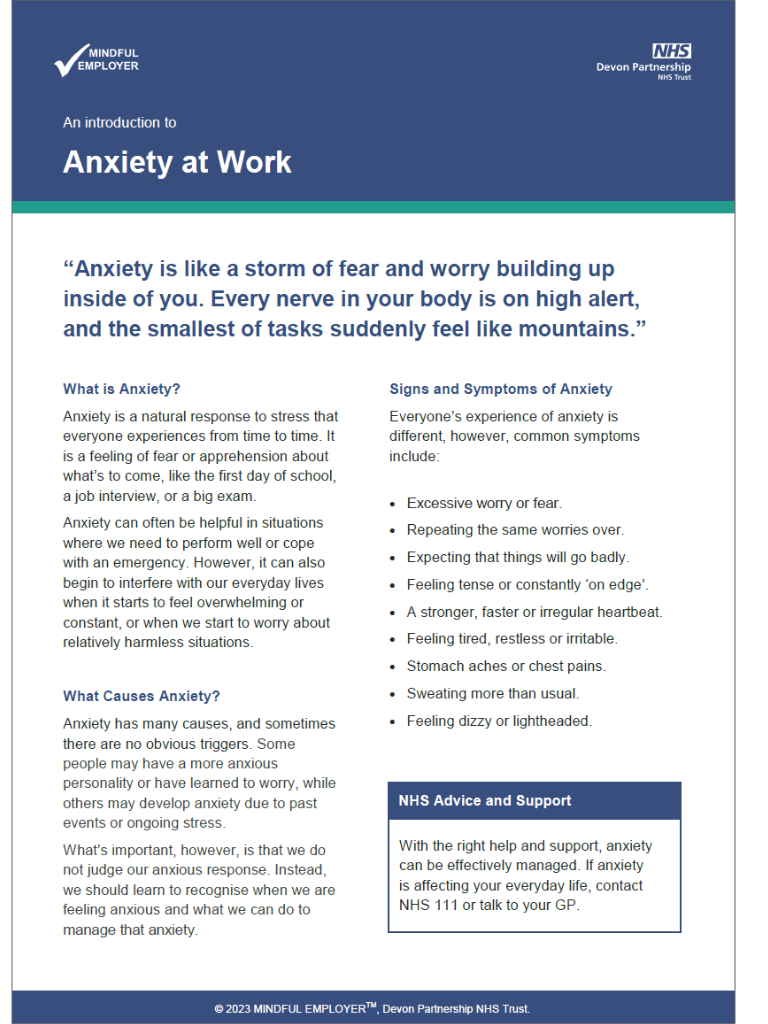Contents:
What is Anxiety? | What Causes Anxiety? | Signs and Symptoms of Anxiety | Managing Anxiety at Work
“Anxiety is like a storm of fear and worry building up inside of you. Every nerve in your body is on high alert, and the smallest of tasks suddenly feel like mountains.”
What is Anxiety?
Anxiety is a natural response to stress that everyone experiences from time to time. It is a feeling of fear or apprehension about what’s to come, like the first day of school, a job interview, or a big exam.
Anxiety can often be helpful in situations where we need to perform well or cope with an emergency. However, it can also begin to interfere with our everyday lives when it starts to feel overwhelming or constant, or when we start to worry about relatively harmless situations.
What Causes Anxiety?
Anxiety has many causes, and sometimes there are no obvious triggers. Some people may have a more anxious personality or have learned to worry, while others may develop anxiety due to past events or ongoing stress.
What’s important, however, is that we do not judge our anxious response. Instead, we should learn to recognise when we are feeling anxious and what we can do to manage that anxiety.
Signs and Symptoms of Anxiety
Everyone’s experience of anxiety is different, however, common symptoms include:
- Excessive worry or fear.
- Repeating the same worries over.
- Expecting that things will go badly.
- Feeling tense or constantly ‘on edge’.
- A stronger, faster or irregular heartbeat.
- Feeling tired, restless or irritable.
- Stomach aches or chest pains.
- Sweating more than usual.
- Feeling dizzy or lightheaded.
| If anxiety is affecting your everyday life, contact NHS 111 or talk to your GP.
Managing Anxiety at Work
While work can provide a sense of structure and routine that helps some people manage their anxieties, others may find that work-related factors such as an excessive workload, long working hours, and the pressure to perform may contribute to feelings of anxiety instead.
When we feel anxious at work, it can significantly impact our job performance. For instance, we might start making uncharacteristic mistakes, miss important deadlines, or find it difficult to make decisions. Left unchecked, this could have an impact on our long-term career goals. However, there are ways to manage our anxiety while at work. To do this, we can try:
- Taking a Breather
Taking a few calm and deep breaths throughout the day can help us to reduce anxiety by bringing our attention back to the present moment and calming the mind. Try breathing in for four, holding for four, and then releasing for four. - Challenging our Thinking
We are often our own worst critics. By thinking more about what we ‘say’ to ourselves and reframing these thoughts, we can reduce feelings of anxiety by building our resilience and capacity to view situations in a more realistic and rational way. Try asking yourself:
“Will this still matter in a year’s time?”
“What is it that I can currently control?”
“How else can I perceive the situation?” - Setting ourselves 'Worry Time'
‘Worry time’ begins by setting aside 20-30 minutes each day for problem-solving. Each time we notice our mind worrying, we can tell ourselves that we will come back to this at ‘worry time’. This way, when worries come into our head throughout the day, we can plan to think about them later, allowing us to refocus our minds on the present moment. Jotting down our worries to think about later can also help us to identify possible patterns and triggers. - Distracting ourselves
Distracting ourselves for at least three minutes can help us to reduce physical symptoms of anxiety. Try studying the things around you, doodling a picture, or counting backwards from 100.
Above all, it’s important to remember we’re not alone. If you’re struggling with anxiety at work, reach out to a trusted colleague or manager for support. Alternatively, you may have access to an employee assistance program or wellbeing champion who can offer guidance and advice.


